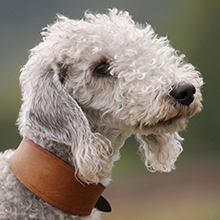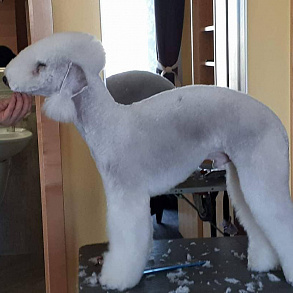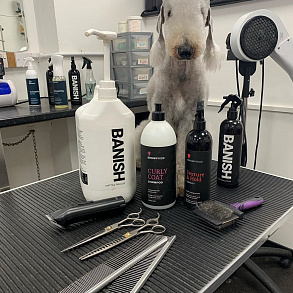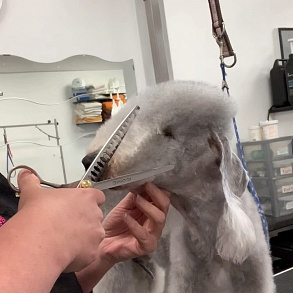Bedlington Terrier

The Bedlington Terrier is an English breed of dog resembling a lamb and poodle hybrid. Historically, Bedlingtons were bred for hunting small game and rodents, and today they are more often found as family pets.
- Brief information
- Highlights
- Breed characteristics
- History of the Bedlington Terrier breed
- Standard of the Bedlington Terrier breed
- Character of the Bedlington Terrier
- Education and training
- Maintenance and care
- Health and diseases of Bedlington Terriers
- How to choose a puppy
- The price of the Bedlington Terrier
Brief information
- Breed Name: Bedlington Terrier
- Country of Origin: UK
- Weight: 8-10 kg
- Height (height at the withers): about 41 cm
- Life expectancy: 11-16 years old
Highlights
- Despite the fact that modern Bedlington Terriers are mainly exhibition dogs and urban companions, representatives of the breed have not lost their hunting instincts.
- In order for Bedlington to look as impressive as possible, it will have to be cut every two months, which is not easy to do in the absence of grooming experience.
- The breed likes to bark, so dogs make good watchmen who are able to warn the owner in time about the presence of strangers in the house.
- Typical terrier traits in Bedlingtons are not as pronounced as in their relatives in the group, although they are not averse to "driving" instead of the owner, as well as chasing small animals.
- The breed is considered rare, so the choice of puppies in domestic kennels is small, and their prices are quite high.
- The Bedlington Terrier is an ideal dog for perfectionists in matters of cleanliness. The molt of the representatives of this family is very moderate, in addition, their hair does not fall out, which means it does not stick to carpets and clothes.
- Bedlingtons have mediocre learning abilities and the 39th place in the list of the most intellectually developed Stanley Koren breeds.
Bedlington Terrier is a devoted friend and an enthusiastic traveler who has a bit of healthy selfishness and a decent reserve of good nature. The breed is recommended as a companion when you want to have a terrier, but there is no desire to acquire a stubborn dominant, controlled exclusively by hunting instincts. Bedlingtons are moderately frisky, but not aggressive, ready to obey a stronger leader, but not to dissolve into him, like to drive small animals, but do not get into a rage and are able to curb their own anger. And these fuzzies have a standard glossy appearance, so with such a pet you will definitely not get lost in the crowd.
Breed characteristics
Video: Bedlington Terrier
History of the Bedlington Terrier breed
The first Bedlingtons appeared in the northern counties of England in the XVIII century. Then the breed was known as the Rothbury Terrier, and gypsies and traveling circus troupes were engaged in breeding its representatives. The ancestors of today's Bedlingtons did not look too presentable, but they demonstrated amazing prowess, providing gypsy families with rabbit stew all year round. The animals were also attracted to work by English slaughterers. Dogs were lowered into the mine to deal with the hordes of rats and mice that lived inside and destroyed the meager lunches of hard workers.
In the XIX century, British Esquires began to acquire Rothbury Terriers. One of the first to do this was William Allan and Edward Donkin, who lived in the vicinity of Northumberland and kept many breeding individuals in their possessions, which were crossed with other breeds. As for the modern name, it came to terriers in 1825, when Northumberland dogs participated in a demonstration hunt in the vicinity of Bedlington.
Since 1859, the breed has won dog shows, and the offspring of its representatives were registered in the stud books of the county of Northumberland. Already in 1893, the Bedlingtons had their own national club, and four years later a separate standard was written for them. Further – more: the descendants of the Rothbury Terriers went to conquer North America, where they were cordially received and even registered in the AKC. By the way, in the era of the "turbulent 20s" in the USA, the breed lines of Colonel Guggenheim and William Rockefeller, who raised the first American Bedlingtons-champions, became especially famous.
The standard of the Bedlington Terrier breed
The modern Bedlington Terrier is a glamorous fashion model with an indescribable plasticity of movements and a noble grace of silhouette. Having tied up with a working specialty in the last century, this charmer quickly transformed into a regular at exhibitions and an elegant companion with whom it is not a shame to show up at a social gathering. Wool plays an important role in the aristocratic image of the Bedlingtons. Fluffy, forming stylish rings on the muzzle, it resembles a bizarre mix of lamb and poodle "fur coats".
Sexual dimorphism in the breed is pronounced. Bitches are shorter and generally more elegant than males. Male representatives have a more textured appearance and pumped-up figures, but at the same time retain their natural grace and light drying of the type. The height range of dogs at the withers is from 37 to 45 cm, the weight varies from 8 to 10 kg.
A haircut with smooth transitions gives Bedlington Terriers a light cosmic chic. Thanks to this technique, the dog's head acquires an emphatically egg-shaped shape, resembling the skull of an alien creature.
Head
The Bedlington Terrier has a narrow, rounded skull of good depth and without a pronounced foot. The top of the head is covered with a fluffy white cap-tuft. The line going to the nose from the back of the head is smooth, without bulges and depressions.
Nose
The lobe is black or brown, depending on the coat color. The nostrils are well outlined, large in size.
Lips, jaws, teeth
The dog's lips fit snugly to the long, narrow jaws. The teeth are large and strong, closing into the right "scissors".
Eyes
The Bedlington Terrier's shiny little eyes are set deep. A mandatory nuance is the angular incision of the eyelids, which makes the eyes look triangular. The color of the iris directly depends on the shade of the coat. Individuals of blue color have dark eyes, those of tan-blue – brown-amber, dogs of liver and sand colors – light walnut shade.
Ears
Bedlington's ear cloth is of medium size, very thin, resembling the outline of a walnut leaf. The ears are set low and lowered down along the cheekbones. The skin on the outside is covered with short velvety fur and has neat fringed tassels on the ear tips.
Neck
The low-set neck of the Bedlington Terrier is devoid of a chin, has a good length and expands in the shoulder area.
Housing
The dog's body is muscular, flexible, in length exceeding the height of the animal at the withers. A distinctive feature of the silhouette is a vaulted back with a domed bend in the lumbar region. The chest of the Bedlington Terrier is deep with flat ribs. The lower abdomen and groin line are well tightened.
Limbs
The front legs are without curvature, but the distance between them at chest level is greater than at the level of the paws. The shoulders of the representatives of the breed are flattened, set obliquely; the pasterns are slightly inclined. The hind limbs of the Bedlington Terrier are more muscular and longer than the front ones. Hock joints are well marked, without eversion. Long hare paws with plump, tightly compressed finger pads look impressive. In a calm environment, the Bedlington Terrier moves with a springy mincing step, but if necessary, it can accelerate to a swinging gallop.
Tail
Bedlington's tail has a normal length, curved shape. It is strong at the base, smoothly turning into a thin tip. A prerequisite is that the tail should not be held above the back.
Wool
Silky thick wool does not fit snugly to the skin, but also does not bulge to the sides. In addition, the hair can curl into rings, which is especially noticeable in the area of the muzzle and head.
Color
Standard suits: blue, tan-blue, liver and sand (with or without tan).
Disqualifying vices
Serious disadvantages of Bedlington terriers are:
- cryptorchidism;
- non-standard coat color and structure;
- brown lobe, lips and eyelids with blue or blue with tan wool;
- undershot or overshot;
- depigmented skin of eyelids, nose lobes, lips.
Behavioral deviations from the norm are also a sufficient reason for disqualification. If the animal behaves cowardly or aggressive, it will not be allowed into the ring.
Character of the Bedlington Terrier
Under the angelic appearance of Bedlington hides a classic "terrier" dog, periodically trying on the crown of the leader and terrorizing small fuzzies under the mood. And yet, decades of exhibition breeding have not been in vain, so the hunting instincts of the breed, of course, are available, but not in such an acute state as, for example, in jagdterriers. The Bedlington Terrier can be called a master of reincarnation. This stylish handsome man is transformed with equal success both into an intelligent good-natured man and into a cunning egoist who fiercely defends his own position.
It is not typical for Bedlingtons to show aggression towards a person, but sometimes a pet is able to make a test "kus" if the owner has crossed the boundaries of what is permissible and has conceived an execution like a planned vaccination or a haircut of claws. The Bedlington Terrier integrates into the society of other dogs without any problems, but this does not mean that he is ready to serve in the pack. On the contrary, this comrade will certainly respond to every provocation from his fellow tribesmen, not forgetting to use branded evasions and sudden bites for the "rear" in the fight.
At home, Bedlington is practically a good girl. He is moderately playful, not annoying and always in a great mood. The breed will not turn the apartment upside down either, although its representatives are characterized by increased energy. But to be jealous of the owner of kittens for a Bedlington terrier is a sacred thing, so in the presence of a dog with purrs, it is better not to be gentle once again. If there are children in the house, the dog is ready to accept this fact as a given, but only on the terms of a polite neighborhood. If the little minx regularly get the animal, causing him discomfort, the Bedlington Terrier can fight back. Keep this in mind and try to limit communication between a pet and children if the latter see a four-legged creature as a living toy.
As for the famous terrier obstinacy, it did not bypass the Bedlingtons. Well, to get acquainted with this trait of the dog's character, it is enough to shout at her properly or infringe on her rights and established habits. The dog will respond to such a "universal injustice" with moderate disobedience, or even a stealthily planned revenge. Otherwise, the Bedlington Terrier is a moderately calm and friendly companion, who loves joint outings into nature and car trips. Yes, sometimes he is not averse to loosen up a neighbor's flower bed and demonstrate the sharpness of teeth on furniture upholstery, but all this is more out of boredom and idleness than out of harmfulness.
Education and training
It is important to answer the question from the very beginning: for what purpose was the dog purchased? If this is a representative of the working lines, with whom a full-fledged hunt is planned, then the educational process will have to be combined with elements of nataski. By the way, once you awaken the hunting instincts in the Bedlington Terrier, you will not be able to pacify them, so either do not start hunting with the breed at all, or do it on a permanent basis. As for domestic and show animals, which are the overwhelming majority in Russia, they can be trained according to the classical scenario: socialization - upbringing – training. Owners of exhibition pets will additionally have to learn the basics of handling (exhibition demonstration of an animal), or entrust this matter to a specialist who will teach the dog a ring stand and correct movements.
Home classes can be combined with trips to training grounds, but such lessons should not mutually exclude each other. Remember, the dog is obliged to execute commands in any situation, and not only when the figure of a professional trainer looms over it. Walking is also better to use usefully for practicing basic skills from the OKD course. However, before starting outdoor activities, the pet should be given the opportunity to run and let off steam.
Otherwise, Bedlington terriers are trained according to the same scheme as the rest of the group, that is, they make it clear that dominance over the owner will not pass. The command given by a person must certainly be executed. It is necessary to start obedience lessons from the age of two months, when the puppy is ready to learn the requirements "To me!" and "Place!". In four months, you can enter more complex commands "Next!" and "Sit!". By the way, about the last team: experts do not recommend introducing it into the skills of show dogs, since animals are exhibited in the ring exclusively in a standing position.
In the first year of life, Bedlington terriers are the most active and full of pranks, so get ready to hide wires, expensive shoes, and also to cover upholstered furniture. It is better to replace all these items with toys that the dog will bite, gnaw and scratch. If the pet has made a mistake, it is impossible to shout at him. Bedlington Terriers agree to recognize the leader of the pack in the owner, but do not tolerate hysterical swearing. In order for the puppy to realize the mistake, a strict tone is enough. And of course, no punishments in hindsight – animals are simply not able to realize their expediency.
Maintenance and care
In the Russian climate, Bedlington Terriers are kept in apartments and houses. At the same time, it is permissible to walk the dog in any weather – for one and a half to two hours of walking in parks and squares, the animal will not freeze. If you want to keep the presentable appearance of the ward, buy a protective jumpsuit for the off-season period. Despite the fact that the Bedlingtons are neat from birth, even they are not immune from dirty splashes flying from under car wheels. However, it is necessary to observe the measure here. Prolonged wearing of waterproof clothes is fraught with the formation of woolen tangles on the dog's body, which do not decorate it at all.
Hygiene and grooming
Bedlington terriers grow abundant hair not only on the body, but also in the ear funnel. In this regard, once a week, the ear canal needs to be cleaned of secretions, simultaneously plucking out hairs that interfere with natural ventilation and accumulate sulfur secretions. The most convenient way to remove hair from the ear is plucking by hand or with tweezers. If the dog overreacts to "hair removal", it is permissible to use scissors with rounded edges.
Once a month, the Bedlington Terrier should trim its claws with a clipper or any other claw cutter. If this is not done, the claw plate will bend inwards, interfering with walking and distorting the set of legs, which is especially disastrous for show pets. Owners walking with animals on roads sprinkled with reagents, it is wiser to put their wards in special waterproof socks. Otherwise, after each such exit, Bedlington will have to heal the cracked skin of the pads. As an alternative to walking socks, it is allowed to use protective waxes and balms for paws such as "Let's go for a walk!", "Vedinol". These products prevent the absorption of chemical compounds into the skin, protecting it from peeling and cracking.
The teeth of the breed are healthy, so to prevent plaque and tartar, it is enough to give the pet a solid treat like dried beef ears, cartilage or dry fortified croquettes. Good results are obtained by greasing the teeth with fresh tomato juice and cleaning the zoo, but the dog is accustomed to such procedures from puppy age.
There is no seasonal molting in Bedlington Terriers. The hair is gradually renewed throughout the year, so the main care for the pet is periodic combing of the body with a rubber mitten or brush to avoid the formation of tangles. Puppies up to a year should be combed more often, since they have a more intense molt. Junior wool changes to adult, and therefore falls off faster. In addition, starting from the age of three months, Bedlington Terriers are sheared. If you do not plan to entrust this procedure to a groomer, get a barber's scissors, a clipper and a fluff brush. The last tool will come in handy to comb the dog's lush hair before processing with a typewriter and scissors.
Most breeders prefer the classic version of the Bedlington haircut with smooth transitions and the design of a lush cap on the head. However, there is also an American technique when the dog is cut as short as possible, and the hair on the lower part of the tail, cheeks and throat is shaved. Bedlingtons trimmed in this type look very unusual due to translucent skin and a narrow "cap" on the skull. As for the schemes of dog "hairstyles", they are easy to find on the breed forums. However, you will have to use templates at least four times a year – if you cut the animal less often, there is a risk of getting a hopelessly overgrown pet in untidy tangles.
Bedlington Terriers need to be bathed every 2-3 weeks. In addition, after each walk, you will have to wipe the animal's paws and lower abdomen. In order for the wool to look shiny and comb better, it is necessary to use conditioners complete with shampoo. More frequent bathing is carried out when the task is to grow the coat faster – the use of softening masks and balms, as well as regular combing make the hair more pliable and stimulate blood circulation. It is also useful to buy talc or baby powder. Over time, the strands near the mouth, under the eyes, tail and on the belly of the dog acquire a brownish undertone, which is easy to neutralize if the coat is treated with talcum powder.
Important: during life, especially during pregnancy and feeding puppies, the Bedlington Terrier coat changes the intensity of color, becoming darker, that's lighter. This is a normal and passing phenomenon that does not need to be fought.
Feeding
The natural menu of the Bedlington Terrier includes any lean meat, frozen fish fillets, low-fat dairy products, fruit and vegetable components and cereals (rice). Vitamin complexes and dietary supplements, which are best selected on the recommendation of a veterinarian, will help to make the diet optimally balanced. Breeders often recommend high-quality industrial feed, starting from the super-premium class and higher. However, to find your ideal manufacturer of "drying", you will have to spend some time.
An important nuance: many mineral components that make up ready-made feeds color the wool of Bedlington terriers, but it is unrealistic to predict in advance how the dog's body will react to a particular brand.
It is unacceptable to feed your pet with leftovers from your own table. In addition, sweets, smoked meats, legumes and cabbage, raw carrots, nuts, chocolate, buckwheat, sweet fruits, as well as offal (liver, kidneys) are contraindicated for the breed. Tubular bones are also not given to Bedlingtons, as well as leafy greens.
Health and diseases of Bedlington Terriers
The Bedlington Terrier is not the most painful breed, but it has a predisposition to some health problems. Most often, its representatives suffer from eye diseases (glaucoma, retinal atrophy, distichiasis), protrusion, as well as hip dysplasia and ectopia of the ureters. The Bedlingtons also have a unique genetic ailment called "copper toxicosis". The disease manifests itself at a young age and is caused by excessive accumulation of copper in the liver. In addition, if the pathology is not treated in a timely manner, the case is pumped with intoxication of the body and a fatal outcome.
As a prevention of toxicosis, it is recommended to revise the pet's menu and exclude copper-rich foods, as well as industrial feeds in which the copper content exceeds 10 mg/kg. It is better to give distilled and deionized water to Bedlington terriers with a tendency to the disease, and replace animal protein with easily digestible fermented milk (cottage cheese, kefir). In addition, with copper toxicosis, it is useful to introduce multivitamin complexes with vitamin K into the diet .
How to choose a puppy
- Be sure to get to know the litter producers. Look at their pedigrees, as well as the results of testing for genetic copper toxicosis, if any. Remember, individuals who have been diagnosed with this disease are officially not allowed to breed.
- Choose a "girl" if you are not sure of your pedagogical abilities – Bedlington Terrier bitches are more manageable and easier to train.
- Keep in mind that Bedlington Terrier puppies are born with a dark chocolate or black coat color, which becomes lighter as the animal matures.
- If the titles of the baby's parents are important, go to dog shows where you can meet the owners of the Bedlington champions and negotiate the purchase of a puppy.
- Walking through exhibitions and choosing breeding individuals from whom you would like to acquire offspring, pay attention to how many Bedlington Terriers are exhibited in the ring. It's great if the manufacturer has received a title and an excellent rating in the course of healthy competition. If one or a couple of contestants were exhibited at the event, there is a possibility that the judges overestimated the participants' ratings.
- Try to acquire Bedlingtons in monopred kennels or from breeders specializing in only one breed – this way there are more chances to get a healthy animal that has been given enough attention.
Price of the Bedlington Terrier
In Russia, Bedlington terriers are quite rare pets, which means that the search for a monopred kennel will have to be conducted not only within the country, but also in the former Soviet republics. As for the cost of puppies, European breeders will be able to purchase a club baby from producers tested for copper toxicosis for 800-1100 euros. In the nurseries of the CIS countries, prices are slightly lower – 400-700 euros (approximately 430 – 760 dollars), depending on the class of the puppy and the purity of its pedigree.


